H. A Malfunctioning unit
In low battery mode the yellow light will flash with a short beep
once every 60 seconds. If a circuitry or sensor fault occurs,
the yellow light will stay permanently on and be accompanied
by 2 short beeps every 60 seconds. Call Customer Services
on +44 (0) 1452 887570 if this should happen.
WARNING: If the green light is off (or not flashing every
minute in battery mode) the alarm may be without power
and therefore will not indicate a fault condition.
J. Tips for the Homeowner
Energy Conservation and Indoor Air Quality
Two steps that homeowners take to conserve energy may
adversely affect indoor air quality. Since air leakage can
account for as much as 40% of heat loss, houses are being
made more airtight. Reduced air leakage will contribute to
higher concentrations of air contaminants from indoor
sources and can cause draught reversal in the central
heating boiler or fireplace chimney when the demand for air
by fireplaces, central heating boilers and exhaust fans
exceed the air supplied by leakage area and supply ducts.
Converting from oil to gas, without taking steps to prevent
chimney deterioration, will increase the risk of chimney
blockage, draught failure and the associated release of
combustion products into the house. You should always use
properly qualified Capita/Gas Safe registered gas installers.
Dirt and Blockage
Never insulate or try to seal up a draught hood, wind cap or
exhaust vent on any gas appliance (central heating boiler,
hot water heater, cooker, dryer or space heater). Keep area
around appliances clean. Don’t store anything that could
restrict air circulation close to equipment. If you have a gas
water heater, make sure that combustion air openings at the
bottom of the tank and the opening below the draft diverter
(on top of the tank next to the flue duct) remain unblocked. If
you have a gas dryer, the exhaust duct must be vented to the
outside and have a hood at the end. Check that the exhaust
system is not blocked by lint or debris and that the flapper
in the hood moves freely.
For all fuel-burning equipment, make sure that vent hoods
and pipes are not blocked by insulation, leaves or bird
nests. If you have pets, make sure that there is no build up
of fur or hair around gas burners or aeration holes.
Using other equipment that consumes or
exhausts household air
If you use exhaust fans, a fireplace or other fuel burning
heaters or stoves:
Run exhaust fans for just a minute or two. Prolonged use
could remove too much air, and it wastes heat.
If your appliance has a conventional flue, beware of running
extraction fans when the gas appliance is on.
When your fireplace, coal or wood stove is operating, open
a window and close off warm air registers in the room or
install a fresh air duct directly to the fireplace or stove so
that it won’t steal air from your central heating boiler
.
Confining or enclosing gas-fired equipment
If you have partitioned off your central heating boiler and
water heater, you may need additional ventilation.
Danger Signs
Stuffy, stale or smelly air, back draughts and soot from a
fireplace or boiler chimney usually means your home needs
more air for proper combustion and healthy living.
For gas-fired equipment, mostly yellow (rather than clear
blue) burner flames, a pilot light that keeps going out, or a
smell of gas indicate trouble. Turn off the equipment and
contact the gas emergency service, number in the telephone
directory, under ‘Gas
’
.
K. Additional Safety Tips
BRK Dicon/First Alert CO alarms are manufactured to the
highest standards to ensure faultless operation and long life.
The manufacturers do, however, recommend that no CO
alarm should be used for more than twelve years, in order to
minimise the chance of a fault occurring. This device
requires no special disposal procedures and may be
disposed of in household refuse. Have your fuel-burning
equipment checked periodically for safety and efficiency by
a qualified service engineer. If you are adding a wood or
coal burning stove to a home, make sure that the stove is
properly installed and vented.
Check with the Building Inspectors Department of your local
council and always use a qualified (Capita/Gas safe
registered) gas installer.
If you have already installed a wood or coal stove without
building regulation approval, consult your local Building
Control Officer. Some ‘do-it-yourselfers’ have unknowingly
created dangerous conditions.
Do not expose yourself to carbon monoxide through
carelessness. Never operate a petrol engine in a confined or
enclosed space such as a garage or tool shed. Never use a
paraffin stove or charcoal grill in a confined space such as a
closed garage or caravan. On brick chimneys inspect and
clean-out regularly to ensure that the chimney is free and
clear of debris.
Regardless of the fuel your boiler, fireplace or stove uses, your
chimney should be inspected from time to time by a
competent person. Any ‘Efficiency’ devices must always be
installed by a Capita/Gas Safe registered installer. When using
paints, household cleaning supplies or similar materials, be
sure that you’re using them in a well-ventilated area. Following
sensible maintenance and safety procedures in the home will
give you fuel savings without endangering your health.
L. Where should you install the alarm?
Which room to put the alarm?
Ideally, you should have an alarm in or near every room that
has a fuel-burning appliance. However, if you have more
than one appliance, but only one alarm, you should take the
following into consideration when deciding where best to
put the alarm.
• If there is a fuel-burning appliance in the room where you
sleep, you should put the alarm in that room.
• If there is a fuel-burning appliance in the room that you
use a lot. e.g. a sitting room, you should put it in that
room.
• If you live in a bed-sit put the alarm as far away from the
cooking appliances as possible, but near to the place
where you sleep.
• If the fuel-burning appliance is in a room not normally
used (e.g. a boiler room) put the alarm just outside the
room so that you will be able to hear the alarm more
easily.
If the alarm is in the same room as the appliance:-
It should be mounted on or close to the ceiling at a height
greater than that of any door or window. It should be at least
300mm from any wall, light fitting or any other obstruction.
If mounted on a wall it should be at least 150mm from the
ceiling. If mounted in a room with a sloped or gabled ceiling
it should be at least I metre lower than the highest point of
the room as long as that is above doors and windows.
If the alarm is in a room that is remote from the appliance,
then the alarm should be in the breathing zone of the
occupants.
• An alarm should be at least 1.8 metres (6 feet) from the
fuel-burning appliance.
Do not put a CO alarm:
• Outside the building.
• In close proximity to a vehicle exhaust pipe; this will
damage the alarm.
• In or below a cupboard.
• In a damp or humid area.
• Near paint thinners, adhesives, polishes, aerosols, or
household cleaning products. Other substances may also
affect the reliability of the unit.
• Directly above a sink or cooker.
• Next to a door window or extractor fan or anywhere that it
would be affected by draughts.
• In exhaust streams from gas engines, vents, flues or
chimneys.
• Where it would be obstructed by curtains or furniture.
• In an area where the temperature could drop below -10ºC
or rise to above 40ºC.
• Where humidity is less than 30% R.H. or more than 90%
R.H.
• Where dirt or dust could block the sensor and stop it
working.
• Where it could be easily knocked or damaged, or where it
could be accidentally turned off or removed.
M. How should you install the alarm?
CO850MBXi
When inserting the battery for the first time remove the
Battery Access Door (see section F) by sliding towards the
side of the alarm. Remove the battery access door screw
from the body of the alarm shown in section F. Remove the
battery from the compartment and connect it to the flying
lead found in the compartment. ONLY USE APPROVED
BATTERIES, either Duracell MN1604, MX1604, GP 1604A
or Energiser 522. Carefully insert the battery back into its
compartment, refit the access door and secure with the
screw removed above. When changing the battery in future
remove the battery access door screw before opening the
door. Test the alarm in accordance with section G.
For mains powered models Mi, MBXi.MRLi
This unit is designed for permanent connection to a 230-
240 VAC 50-60Hz supply. The maximum current draw is
45mA – select fuse accordingly.
1. ELECTRICITY MUST BE TURNED OFF AT THE
DISTRIBUTION BOARD BEFORE COMMENCING ANY
WORK IN ORDER TO PREVENT ELECTRICAL SHOCK OR
EQUIPMENT DAMAGE.
2. Select a suitable location in accordance with the
guidance in section L of this manual and complying with
the requirements set out above.
3. Remove CO alarm and pattress from packaging.
4. Place pattress at chosen location with the connector
block uppermost. Mark and then drill holes for suitable
fixings, corresponding to the slots in the base of the
pattress.
5. Bring supply wires from mains into the pattress.
N.B. The CO850 mains powered series are supplied
complete with a pattress within which wiring connections
are made and does not therefore require a junction box. The
pattress is provided with knockouts in the base for entry
from the back or an end port knockout for mini-trunking.
6. Secure pattress to mounting surface using suitable
fixings.
7. Connect the incoming live wire to the terminal marked L,
the incoming neutral wire to the terminal marked N and
the incoming green and yellow earth wire into the unused
terminal marked E.
This alarm can be interlinked to 11 other CO alarms (12 in
all). To interlink to another alarm connect the incoming wire
used for the interlink connection to the terminal marked I
The incoming wire must be rated the same as the incoming
live and neutral.
NOTE: NO connection should be made to the mains supply
earth terminal. Simply secure the incoming earth wire at
terminal marked E to prevent contact with live neutral or
interlink wires.
8. Carefully offer the alarm up to the pattress ensuring the
connection pins locate into the sockets in the pattress.
9. Secure alarm to pattress using securing screws supplied
in a separate polythene bag.
NOTE: MRLi model only. This version contains
pre-charged, rechargeable Lithium ion batteries.
On installation some alarms may chirp once a minute
for up to 2 hours whilst the batteries 'top up'.
10. Turn electricity supply back on.
11. Ensure the green power light is on and then press the
test button. The alarm will sound 2 series of 4 beeps
with red light followed by a single flash of the yellow
and green lights.
12. If the alarm is interconnected to other CO alarms,
pressing the test button on one alarm will cause the
others to sound within a few seconds. The red light will
only show on the originating alarm.
N. Technical information
Your alarm utilizes a proprietary Electronic Sensing
Technology that permits the unit to vary the exposure time
before the alarm sounds based on carbon monoxide
concentrations.
The carbon monoxide concentrations and time standards for
the alarms are as follows:
O. Guarantee Information
Limited Guarantee
Your alarm, excluding the battery in the CO850MBXi models,
is warranted for 5 years from the date of purchase against
defect in material and workmanship. Units returned to BRK
Brands Europe Ltd with proof of purchase date during this
period as a result of such defects will be repaired, or replaced
at BRK Brands Europe Ltd’s option, without charge. This
warranty only covers defects in material or workmanship in
normal residential use and does not cover damage resulting
from negligent handling, misuse or lack of reasonable care.
YOUR ALARM IS NOT A SUBSTITUTE FOR PROPERTY,
DISABILITY OR OTHER INSURANCE OF ANY KIND.
APPROPRIATE COVERAGE IS YOUR RESPONSIBILITY,
CONSULT YOUR INSURANCE AGENT.
This warranty does not affect a customer’s statutory rights in
any way.
In the event of a problem with your alarm or you have any
questions concerning use and care of the product or
concerning service, please consult your owners manual.
If you require further help or clarification, please write:
BRK Brands Europe Ltd
Unit 6, Carter Court
Davy Way
Waterwells Business Park
Quedgeley
Gloucester
GL2 2DE
United Kingdom
www.brkdicon.eu
PLEASE KEEP THIS MANUAL IN A SAFE PLACE
Please note that specifications may be subject to change.
Important:
Please read and retain this owner's manual. When installing
this alarm for use by others, please leave this manual or a
copy with the end user and ensure they are fully conversant
with its siting, operation and maintenance.
BRK Brands Europe Helpline +44 (0)1452 887570
Installation
installed. It should not be used on an intermittent
or chimneys.
(BS7671).
wall switch. It is recommended that CO alarms be wired
supply.




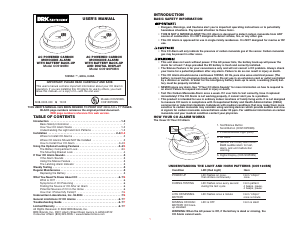
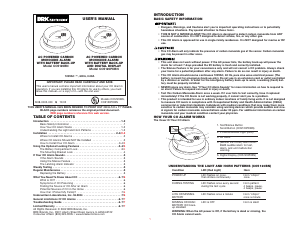
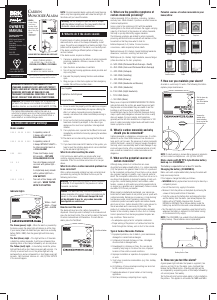
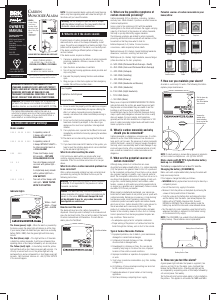
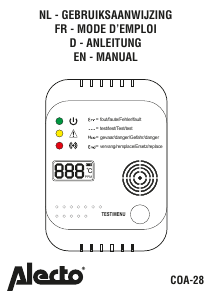
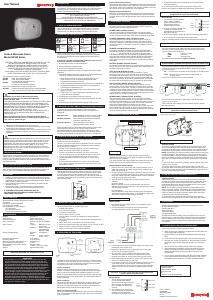
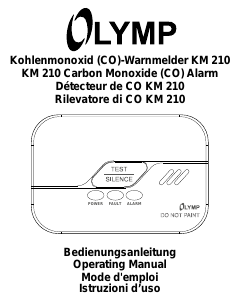
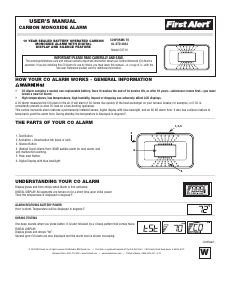
Join the conversation about this product
Here you can share what you think about the BRK Electronics CO850MRLi Carbon Monoxide Detector. If you have a question, first carefully read the manual. Requesting a manual can be done by using our contact form.